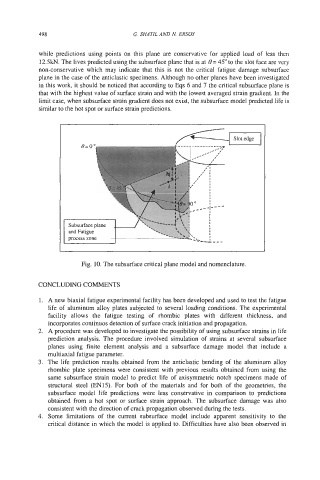Page 514 - Biaxial Multiaxial Fatigue and Fracture
P. 514
498 G. SHATIL AND N. ERSOY
while predictions using points on this plane are conservative for applied load of less then
12.5kN. The lives predicted using the subsurface plane that is at 8= 45Oto the slot face are very
non-conservative which may indicate that this is not the critical fatigue damage subsurface
plane in the case of the anticlastic specimens. Although no other planes have been investigated
in this work, it should be noticed that according to Eqs 6 and 7 the critical subsurface plane is
that with the highest value of surface strain and with the lowest averaged strain gradient. In the
limit case, when subsurface strain gradient does not exist, the subsurface model predicted life is
similar to the hot spot or surface strain predictions.
<I Slot edge
Subsurface plane
and Fatigue -. . '4 I
process zone ------::-<. I I _
-a,--! - -
I I
I
Fig. 10. The subsurface critical plane model and nomenclature.
CONCLUDlNG COMMENTS
1. A new biaxial fatigue experimental facility has been developed and used to test the fatigue
life of aluminum alloy plates subjected to several loading conditions. The experimental
facility allows the fatigue testing of rhombic plates with different thickness, and
incorporates continuos detection of surface crack initiation and propagation.
2. A procedure was developed to investigate the possibility of using subsurface strains in life
prediction analysis. The procedure involved simulation of strains at several subsurface
planes using finite element analysis and a subsurface damage model that include a
multiaxial fatigue parameter.
3. The life prediction results obtained from the anticlastic bending of the aluminum alloy
rhombic plate specimens were consistent with previous results obtained from using the
same subsurface strain model to predict life of axisymmetric notch specimens made of
structural steel (EN15). For both of the materials and for both of the geometries, the
subsurface model life predictions were less conservative in comparison to predictions
obtained from a hot spot or surface strain approach. The subsurface damage was also
consistent with the direction of crack propagation observed during the tests.
4. Some limitations of the current subsurface model include apparent sensitivity to the
critical distance in which the model is applied to. Difficulties have also been observed in

